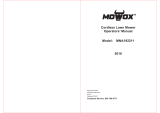
Self-propelled drive roller (550R / 550HR / 550RS) ; Mowing hints
ENGLISH 12
9. Self-propelled drive roller
(550R / 550HR / 550RS)
On lawn mowers with self-propelled drive, the drive
lever is located in front of the guide bar. The self-
propelled drive can only be put into gear after the
engine starts. To engage the drive, the drive lever (2),
has to be pulled towards the grip bar. To stop the drive,
release drive lever. In its released state, there is no
drive and the lawn mower can be pushed forward or
backward.
Self-drive with variable speed selection
(type 550RS/550HR)
Your SOLO lawnmower 550RS/550HR is equipped with
a variable speed self-drive mechanism. The drive is
provided by belt via a gearbox with variable speed
driving the rear wheels.
The variable driving speed can be selected as required
using the control lever (item 17).
approx. 2.6 km/h - approx. 4.8 km/h
Note: Only change the driving speed via the
control lever (item 17) with the engine running.
In use, the driving speed can be changed at random
with the drive engaged (item 17).
10. Mowing hints
When mowing, please observe the safety
recommendations which are part of this owners
manual!
Important Note: The time and duration when
lawn mowers can be operated may be subject
to local ordinances. These ordinances usually
vary from location to location.
Noise is damaging. During extended mowing,
we recommend wearing protective head gear to
avoid possible hearing loss.
Before mowing, search the lawn and carefully remove
any debris (stones, shards, metal objects, twigs, etc.).
Leaves, cuttings, etc. do not need to be removed prior
to mowing, but can be picked up with the grass catcher.
10.1 Mowing with Grass catching device
A sharp blade is essential for best cutting results. A dull
blade (grass stems become ragged during cutting and
the lawn turns yellow) has to be resharpened (see
chapter „Blade“).
Short and dry grass can be easily blown in the grass
catching device (6). This is made possible by blower-
supported grass ejection (turbo effect).
The shorter the cuttings, the better the grass catcher
handles them;
- excessively long or wet grass could possibly clog-up
the catcher or slow down the pick-up.
In case of long grass, therefore, first cut with a higher
setting in one direction (with generous overlap) and
then across the first pattern with a lower or the standard
cutting height (Fig. 6).
Grass height, density and grass dampness determine
cutting results. Grass that is dry and not too long
assures best cutting results. Wet grass may be cut and
collected; however, the cutting results and the collection
outcome are affected.
10.2 Lawn Care
If possible, mow only when the lawn is dry and when
the ground is dry. The lawn mower‘s wheels press into
the wet ground and leave compression marks.
A lawn looks better and appears more uniform if cut
often. Frequent cutting allows the lawn to become
healthy since the growth goes into the stem.
Short cuttings up to 1 cm (approx. 1/2 inch) may be left
on the ground, longer cuttings need to be collected with
the grass catching device. At Spring time, the first
mowing should take place approx. 2 to 3 weeks before
the grass grows at its usual level. In order to achieve
early greening of the lawn, cut only approx. 1.5 cm (3/4
inch) of the grass. Check lawn for foreign objects
(rocks, glass, metal pieces etc.) prior to mowing lawn.
The grass catching device can be used for any
additional clean-up (leaves etc.).
Newly seeded or thin lawns must not be cut too short
(leave 3 - 4 cm) (1 - 1 1/2 inches). Let the grass remain
at that length for 4 to 5 weeks, so that the lawn
increases in width and density.
Attention: SOLO Lawn mowers with rear eject are
especially suited for the collection of leaves.
However, this use is only permitted on lawns where
all foreign objects, such as stones, shards, metal
objects, twigs, etc. have first been carefully
removed. Leaf collection on solid ground (for example,
roads or walk-ways) is prohibited due to inherent safety
risks.
For leaf collection, the cutting height is to be set to the
middle or to the highest setting.
Fig. 6


















